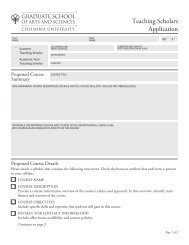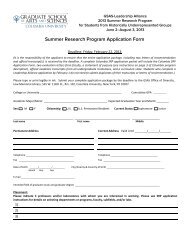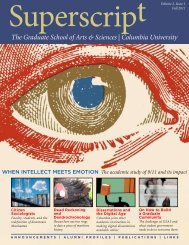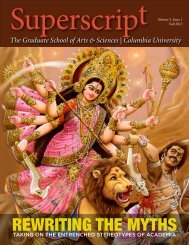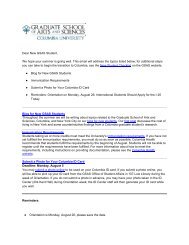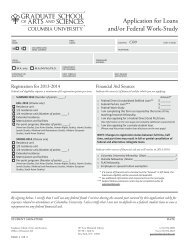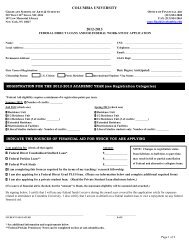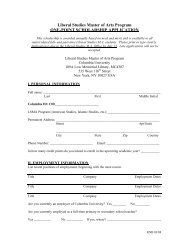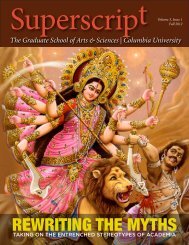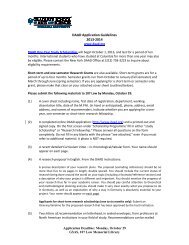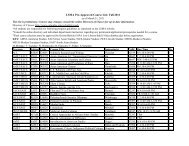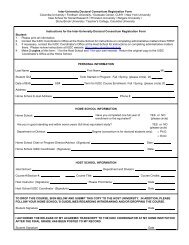PDF for Printing - Graduate School of Arts and Sciences - Columbia ...
PDF for Printing - Graduate School of Arts and Sciences - Columbia ...
PDF for Printing - Graduate School of Arts and Sciences - Columbia ...
- No tags were found...
Create successful ePaper yourself
Turn your PDF publications into a flip-book with our unique Google optimized e-Paper software.
When she began interviewingtherapists, one <strong>of</strong>Seeley’s first observationswas their struggle to properlylabel their patients’suffering. Existing psychiatriccategories did notfully capture it.Pr<strong>of</strong>essor Karen Seeleyfrom Marylene Cloitre, a research <strong>and</strong> clinical psychologist<strong>and</strong> trauma specialist at NYU. Cloitre brought to the projecta team <strong>of</strong> psychologists who advised on interview techniques<strong>and</strong> provided pr<strong>of</strong>essional services to subjects <strong>and</strong> researcherswhen needed. Sometimes, however, their services as therapistswere not wanted. Many interviewees were willing to talk withthe oral historians because they were not psychologists. Clarkcould underst<strong>and</strong> that reaction. “Human suffering precedes<strong>and</strong> supersedes medical diagnosis. It can’t be fully expressed.”Who Counselsthe Counselors?Practicing psychotherapist <strong>and</strong> anthropology pr<strong>of</strong>essor KarenSeeley was not a trauma specialist when she began her 9/11-relatedresearch. In fact, she didn’t want to research September11th at all. “My first instinct was to find some distance.” In2002, however, <strong>Columbia</strong> sociologist David Stark contactedher. He was completing a study <strong>of</strong> the response to 9/11 in thecity <strong>and</strong> wished to include specific occupational groups (seepage 26). He asked if Seeley would be interested in studyingtherapists <strong>and</strong> their post-9/11 work.When she began interviewing therapists, one <strong>of</strong> Seeley’sfirst observations was their struggle to properly label theirpatients’ suffering. Existing psychiatric categories did not fullycapture it. “There was a general consensus that [Post-TraumaticStress Disorder (PTSD)] was the closest thing psychiatryhad to <strong>of</strong>fer” in terms <strong>of</strong> defining what was happening. PTSDrequires the existence <strong>of</strong> an external event in order to be diagnosed,<strong>and</strong> 9/11 fit the bill <strong>for</strong> many New Yorkers. PTSD, however,was not included in the Diagnostic <strong>and</strong> Statistical Manual<strong>of</strong> Mental Disorders until 1980, <strong>and</strong> many <strong>of</strong> the therapistsSeeley was interviewing had no training or experience with it.Be<strong>for</strong>e September 11th, few therapists specialized in trauma.Though Seeley thought that “PTSD may not have been themost appropriate way to categorize what people felt after 9/11,therapists started to take crash courses in trauma just to try toget a sense <strong>of</strong> what it was <strong>and</strong> how to treat it.”Seeley also found that therapists were struggling with morethan their pr<strong>of</strong>essional ability to address patient trauma. Theywere struggling with trauma themselves. “I anticipated thattherapists would have processed their personal reactions to9/11. I was surprised to see how desperate many <strong>of</strong> them wereto talk…about what they were going through [in their personal<strong>and</strong> pr<strong>of</strong>essional lives]. They were having very powerful reactionsto their work that they couldn’t quite get a h<strong>and</strong>le on.”For many <strong>of</strong> the therapists, meeting with Seeley was the firstopportunity they had in over a year to reflect on their own ex-Link back to contents page24 Superscript



